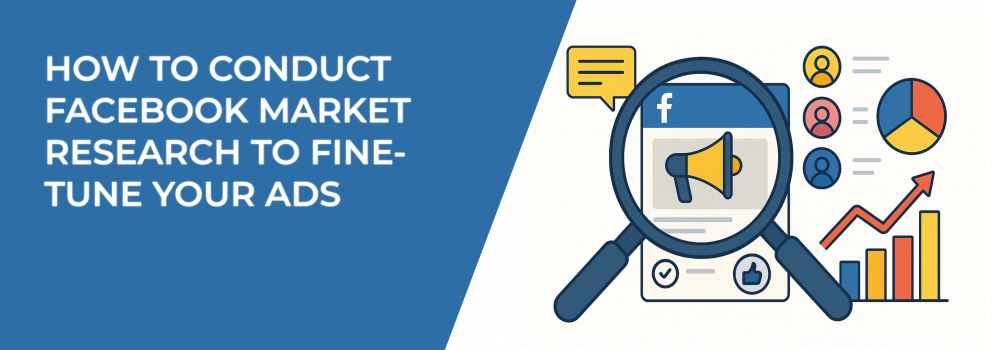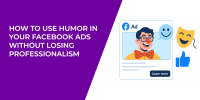If you want your Facebook ads to get better results, the first thing to improve isn’t always your visuals, your copy, or your budget. It’s your understanding of your audience. Facebook is full of data — not just in analytics dashboards, but in behavior, comments, engagement patterns, and ad trends. The problem is, most advertisers don’t take full advantage of what they can learn.
So how can you conduct effective market research on Facebook, without overcomplicating things or wasting hours guessing what people want?
Here’s a step-by-step breakdown of how to research your audience properly — and use those insights to run smarter, more profitable ad campaigns.
1. Start by understanding the audience you already have
Before you try to attract new audiences, take a closer look at the people who are already interacting with your content. This helps you avoid guesswork and uncover real patterns in your data.
In Meta Business Suite and Ads Manager, review these core areas:
-
Demographics: identify age groups, gender distribution, and locations with the most engagement;
-
Device behavior: find out whether users are on mobile or desktop, and which devices convert best;
-
Top-performing content: look at which posts got the highest engagement (likes, shares, comments), and identify what formats were used (video, image, carousel);
-
Engagement timing: review when your followers are most active during the day or week;
-
Creative patterns: see if certain styles — such as casual photos vs. polished graphics — consistently perform better.
Once you have this data, look for patterns. Maybe your younger audience clicks more, but your older audience converts more often. Or maybe one format gets a high click-through rate, but a different one gets better conversion.
After analyzing your audience, you can discover which demographic and behavioral segments make up the major part of your potential customers
Use those details to:
-
Shape your messaging;
-
Improve your visuals;
-
Choose better placements;
-
Adjust your budget by audience segment.
The more you understand who’s already paying attention, the easier it is to reach more of the right people.
2. Use Facebook’s Audience Insights to discover new segments
Meta’s Audience Insights tool is still a useful way to explore potential audiences based on interests, behaviors, and demographics.
You can enter a keyword — like “organic skincare” or “real estate investing” — and see who’s most interested in those topics. From there, you can start building profiles.
Pay attention to:
-
Age and gender breakdowns: spot which groups show the most interest;
-
Location trends: identify cities, states, or regions where interest is higher;
-
Device use: see whether mobile or desktop is more common, which affects how you design ads;
-
Other interests: discover what else your audience follows — such as related brands, influencers, or media sources.
These insights help you test new angles or creative themes. For example, if users interested in “eco-friendly clothing” also follow certain travel or wellness brands, that might shape your ad messaging or partnerships.
You don’t need to act on every single data point. But when used thoughtfully, this tool can validate targeting ideas before you invest in ad spend.
To go beyond surface-level demographics and dig into user behavior, you can use Facebook’s built-in tools to segment by intent. Learn more in this guide on how to identify high-intent audiences using Facebook Insights.
3. Study competitor ads using the Meta Ad Library
The Meta Ad Library lets you see which ads any Page is running. It’s an excellent way to learn from brands in your space, whether they’re direct competitors or simply reaching the same kind of customer.
Using Meta Ads Library, you can see how your competitors might approach advertising differently even for identical products. These insights can help you understand your target market better
Here’s what to look for when reviewing competitor ads:
-
Creative type: are they using video, Reels, images, or user-generated content?;
-
Messaging style: are their headlines focused on emotion, benefits, urgency, or pricing?;
-
Calls to action: what actions are they prompting — Learn More, Shop Now, Sign Up?;
-
Content themes: are they promoting sales, tutorials, testimonials, or lifestyle stories?;
-
Ad variety: are they running lots of variations or sticking to one core message?
After reviewing several ads, look for gaps or weaknesses. Are they ignoring specific customer objections? Is their tone too generic? Are they using outdated visuals?
You can also read through ad comments to see how people are responding. Sometimes, users share honest feedback, ask questions, or express concerns. Those comments give you clues about what to clarify or emphasize in your own ads.
For a step-by-step breakdown of how to evaluate creative choices, positioning strategies, and ad frequency, check out the ultimate guide to analyzing your Facebook competitors' ad campaigns. It’s packed with practical tips to help you go from passive observation to strategic insight.
4. Use Custom and Lookalike Audiences as research tools
Custom Audiences and Lookalike Audiences aren’t just for targeting — they also help you learn how different groups behave when exposed to your ads.
Start by building Custom Audiences based on:
-
Website visitors: people who’ve visited your site but didn’t convert;
-
Video watchers: users who watched at least 50% or 75% of your content;
-
Social engagers: people who’ve liked, saved, or commented on your posts;
-
Email subscribers: users who’ve joined your list or downloaded a freebie.
Then, test how each group responds to different types of content. Do email subscribers prefer in-depth product information, while video watchers engage more with quick testimonials? Track results by ad set and learn from the differences.
Next, build Lookalike Audiences based on high-value segments — such as your top buyers or most engaged followers. Test different ad formats and track which Lookalike group brings the best return.
Compare performance by:
-
Click-through rate: which group shows the most interest?;
-
Conversion rate:who is actually buying or signing up?;
-
Engagement behavior: are certain groups liking or sharing, but not converting?
This kind of segmentation helps you identify which audience traits matter most and gives you a more nuanced understanding of your customers.
5. Ask your audience directly through social interactions
You don’t always need analytics to learn about your audience. You can simply ask them.
Facebook and Instagram make it easy to start conversations through:
-
Story polls and quizzes: ask users to choose between product options, packaging designs, or use cases;
-
Q&A stickers: let people share questions, opinions, or challenges;
-
Comment prompts: post a question in your caption and encourage followers to share;
-
Live sessions or Reels: use video to ask questions and see how people respond in real time.
Some example questions you could ask:
-
“What’s the biggest challenge you face when shopping for [product type]?”;
-
“Which of these colors would you choose for a summer collection?”;
-
“What made you try our brand for the first time?”;
-
“What kind of content would you like to see more of from us?”.
These responses help you write better ad copy, choose more relevant visuals, and remove barriers to conversion. Plus, engaging directly with your audience strengthens your relationship with them — which can make your ads feel more personal and trustworthy.
6. Pay attention to what’s trending in your niche
Beyond data and direct feedback, there’s another research method you shouldn’t overlook: observation.
Spend time browsing Facebook and Instagram as a user, not just as a brand. Look at what's popular in your industry or community.
Here’s what to look for:
-
Trending hashtags: What themes or campaigns are gaining attention?;
-
Shared content: Which Reels, memes, or posts are getting reposted frequently?;
-
Visual trends: Are brands using minimalist design, bold colors, or certain fonts?;
-
Influencer activity: What topics are creators in your niche talking about?
Even if you’re not running an influencer campaign, their content often reflects what your audience is already paying attention to. Aligning your ads with that context — while staying true to your brand — helps your message land more naturally.
This kind of cultural awareness makes your advertising feel more relevant and connected.
Final thoughts
Facebook market research doesn’t require complex tools or a massive budget. What it does require is a consistent habit of observing, listening, testing, and learning.
Use the data you already have. Explore what Meta makes available for free. Pay attention to how people interact — with your content and with others’. The more clearly you understand your audience, the more effective your targeting, your creative, and your offers will be.

